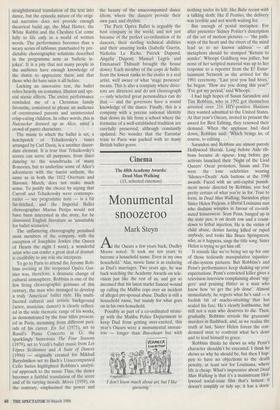Dance
Alice in Wonderland (English National Ballet, London Coliseum) Soiree Jerome Robbins (Paris Opera Ballet, Opera Gamier)
The art of
arrangement
Giannandrea Poesio
Many choreographers have found in Lewis Carroll's Alice in Wonderland an alluring and challenging touchstone for their creative abilities. None of the many works based on this book, however, has become an outstanding example of choreo- graphic art — for Carroll's unique prose cannot be translated into movement.
Derek Deane's Alice in Wonderland for English National Ballet is the latest of these choreographic attempts and another unsuccessful one. Deane has opted for a straightforward translation of the text into dance, but the episodic nature of the origi- nal narrative does not provide enough theatrical build up; the Mad Hatter, the White Rabbit and the Cheshire Cat come fully to life only in a world of written words. The performance becomes thus a weary series of tableaux, punctuated by pre- dictable choreographic solutions described in the programme note as 'balletic in- jokes'. It is a pity that not many people in the audience have enough knowledge of the dance to appreciate them and that those who do have seen it all before.
Lacking an innovative text, the ballet relies heavily on costumes, illusion and spe- cial scenic effects. The entire performance reminded me of a Christmas family favourite, conceived to please an audience of overstressed parents and uninterested crisp-eating children. In other words, this is Nutcracker dressed up as Alice, amid a crowd of panto characters.
The music to which the ballet is set, a hotchpotch of Tchaikovsky's tunes arranged by Carl Davis, is a another discor- dant element. It is true that Tchaikovsky's scores can serve all purposes, from disco dancing to the soundtracks of many B-movies, but to underline some of Alice's adventures with the tsarist anthem, the same as in both the 1812 Overture and Slavonic March, does not make much sense. To justify the choice by saying that Carroll and Tchaikovslcy were contempo- raries — see programme note — is a bit far-fetched, and the Imperial Ballet choreographer Marius Petipa would not have been interested in the story, for he dismissed English literature as 'unsuitable for ballet scenarios'.
The unflattering choreography penalised most members of the company, with the exception of Josephine Jewkes (the Queen of Hearts the night I went), a wonderful artist who can confer a great deal of dramat- ic credibility to any role she interprets.
To go to Paris to attend the Jerome Rob- bins evening at the reopened Opera Gar- flier was, therefore, a dramatic change of cultural atmosphere. Robbins is one of the few living choreographic geniuses of this century, the man who managed to develop a truly 'American' ballet style. His multi- faceted cultural and artistic background (actor, musician, dancer) is clearly reflect- ed in the wide thematic range of his works, as demonstrated by the four titles present- ed in Paris, stemming from different peri- ods of his career. En Sol (1975), set to Ravel's Piano Concerto in G; the sparklingly humorous The Four Seasons (1979), set to Verdi's ballet music from Les Vepres Siciliennes and A Suite of Dances (1994) — originally created for Mikhail Baryshnikov set to Bach's Unaccompanied Cello Suites highlighted Robbins's analyti- cal approach to the music Thus, the dance becomes a faithful translation of the score and of its varying moods. Moves (1959), on the contrary, emphasised the power and the beauty of the unaccompanied dance idiom, where the dancers provide their own pace and rhythm.
The Paris Opera Ballet is arguably the best company in the world, and not just because of the perfect co-ordination of its dancers, their sterling technical abilities and their amazing looks (Isabelle Guerin, Nicholas Le Riche, Patrick Dupond, Angelie Dupont, Manuel Legris and Emmanuel Thibault brought the house down). Each member of the corps de ballet, from the lowest ranks to the &odes is a real artist, well aware of what 'stage presence' means. This is also a company where direc- tors are directors and do not choreograph — only selected great personalities can do that — and the governors have a sound knowledge of the dance. Finally, this is a company with a precise national identity that draws its life from a school where the formulae of a well-established tradition are carefully preserved, although constantly updated. No wonder that the Eurostar train to Paris was packed with so many British ballet-goers.



























































 Previous page
Previous page